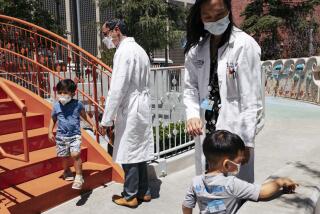Infant Illness Is More Common in Day Care Than Home, Study Says
- Share via
Children in day care are more likely to get respiratory infections and stay ill from them longer during the first year of life than children who are cared for at home, according to results of a study presented Thursday at a pediatric research conference in Anaheim.
“The results confirm everybody’s expectations, but this study attaches some numbers to it,” said Dr. Ellen Wald of the University of Pittsburgh School of Medicine, who presented the findings at the conference. “There has been a lot said in the lay press about day care centers being ‘infested waters’ but not precise documentation of the risk. We wanted to know, Do children really get more infections? If so, how many more do they get and how severe (are they)?”
She also said that further study may indicate that by age 3 or 4, “these kids will have developed an immunity to common viruses in the community, whereas kids who have been cared for in the relatively isolated home setting will experience more infections their first time out as they enter preschool.”
153 Children Tracked
For one year, Wald and her colleagues, Carol Byers and Dr. Barry Dashefsky, followed 153 children who were born between June, 1985, and April, 1986, at Magee Women’s Hospital in Pittsburgh. Parents enrolled in the study agreed to keep a standardized medical diary of their children for 12 months, as researchers monitored the type, duration and frequency of illnesses in either a home-care, group-care or day-care setting.
Home care was defined as care provided in a residential setting to one or more children of a single family; group care as two to six children in a residential setting and day care as seven or more children cared for outside the home.
Wald and her team found that of the children who had experienced six or more infections during their first year, 73% of them were in day care, 65% were in group care and 29% were in home care. Almost all infections experienced by the children were colds, ear or sinus infections.
The study also measured the incidence of severe illness, defined as one that lasted 10 days or more, required a physician’s attention or was characterized by high fever (102 degrees or higher) for at least three days.
Of the children who experienced at least four severe illnesses, 67% were in day care, 39% were in group care and 21% were being cared for at home.
Wald also found that 21% of the children in day care required middle ear tube insertion because of recurrent ear infections contrasted with only 4% of those who were at home.
“Even though children in day care have had more illnesses, we are talking about mild respiratory illnesses that are more of a nuisance than anything else,” Wald said. “They are not catastrophic and are probably inescapable.”
Wald said that working parents, many of whom feel guilty for placing their infants in day care, can look on the bright side with the attitude: “We’ll take a few extra snotty noses now, but in the long run it will all even out.”
‘A Fact of Life’
“I do believe that day care is here to stay,” said Wald, who is a practicing pediatrician at Children’s Hospital of Pittsburgh. “It’s a fact of life in 1987, when nearly 50% of women with children less than 1 year of age are working outside the home.”
In the best of all worlds, Wald said, it would probably be better to keep a child at home for the first year when he or she is most vulnerable to catching other people’s infectious bacteria. “But not everybody has a family member living near by or the finances to do that,” she said.
Wald said she regards this first study as a pilot study and hopes to get government funding to track children through age 5.
“To put these results in perspective, we need to continue to follow these children to see if the trends continue,” she said.






